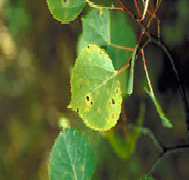Aspen Leaf Spots Description
Aspen leaf spots are also commonly called Marssonina leaf spots. They are the dark brown spots with usually yellow halos that form on leaves. Some newly formed spots will also have white
centers. It’s possible for multiple spots to fuse together to create a larger and deadlier patch.
What Are Marssonina Aspen Leaf Spots?
Aspen leaf spots appear on diseased cottonwoods and aspen trees. They are in both forested and urban areas, and the disease can spread extremely quickly. It’s a fungal infection, spread through microscopic spores in the wind. Any tree within the vicinity of a diseased tree is at great risk of developing the fungal infection. The earlier infections usually don’t pose as much of a harm as the secondary infections. It can depend on the weather. Warmer, wetter weather creates the perfect climate for the spores to spread and mass-produce. Last spring is one of the best times of year, with secondary infections causing problems later in the year.
Getting rid of the infection isn’t as easy as waiting for the fungus to die. Marssonina will survive throughout the winter on the fall leaves. It then spread throughout the next spring.
Spot Appearance on Cottonwoods and Aspens
The spots will usually initially appear as dark black or brown spots. Immature spots can also have white on the inside, but the white speckles disappear with time. As the spots continue to grow, they turn lighter brown with a yellow halo around them. They will continue to grow, connecting with each other and eventually killing off the leaves on the trees.
The fungus symptoms can look similar to another fungal infection on cottonwoods and sometimes aspens; Septoria. Both infections occur at around the same time of year, and management for both is similar. Confusing them is not too much of an issue, but a tree surgeon will know the sight of the fungi and best treatment plans.


